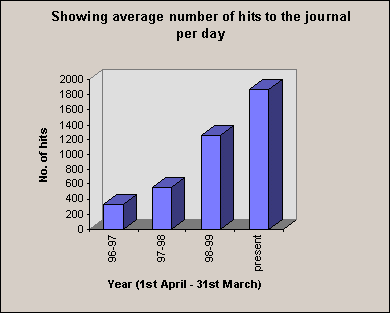Cite this as: Winters, J. 1999 Editorial, Internet Archaeology 7. https://doi.org/10.11141/ia.7.8
The publication of three more articles (Jones, Kemp and Nicholson) from the International Council of Archaeozoology (ICAZ) conference proceedings, subtitled Fishes and Humankind, heralds the close of Issue 7 of Internet Archaeology. The issue also contains a further four short articles that pick up some of the threads of debate on electronic publication and the use of the Internet within archaeology first aired in Issue 6, with topics ranging from the web as a research tool (Buck et al.), to structuring online archaeological information (Gray and Walford) to the web as an experimental and useful publishing medium (Wickham-Jones and Basu).
The publication of Melissa Terras's article concerning the VRML representation of an Egyptian tomb followed closely on their heels in November and, media interest aside, has rapidly become one of the most popular and most accessed articles in the journal so far. This should not come as a total surprise since the highlight of the article is the fully functioning VR model of the tomb itself, incorporating interactive elements and photorealistic representation of the tomb paintings, as well as a partial 'fly-through' animation. However, the model was very large (over 20 MB) and is probably not something we would have felt able to publish a few years ago, given the browser technology available to most readers. But, it is encouraging to see from our access statistics that the majority of readers now use browsers that more fully support such "cutting edge" technology. The submission of articles that explore the some of the current limits of the web are also starting to filter through, so, if you have a truly multimedia project in progress, then do consider publishing it in Internet Archaeology, and reach the parts that other paper journals can't! Our planned themed issue on "Visualisation and Computer-Aided Reconstruction" may be just the opportunity.
What is surprising is that the most accessed file of the VRML article so far is not, as one might have expected, the Virtual Reality model, but rather the PDF file of the accompanying text. I suppose it shows that until we can easily read online journals on the train or in the bath, then there will always be room for paper counterparts!
This trend in readers' preferences emerged in my usual weekly trawl through the journal's access statistics. Our number of registered readers, incorporating individuals from over 108 different countries, has more than doubled from this time last year to 21,994, as of today 22 December 1999 (figure 1). The average number of hits to the journal per day (figure 2) has also been doubling year on year.#

Figure 1: increase of registered readers for Internet Archaeology since October 1998

Figure 2: average number of hits to Internet Archaeology per day since April 1996
present = 1st April to 22 December 1999
Not least, this "take-up rate" is encouraging, considering our plans to cover our costs when our grant from eLib finally runs out in 2001. By that time we hope to be self-sufficient, generating income from a mixture of publication subventions and charging for access through subscriptions.#
The Internet Archaeology Steering Committee met early in December and has decided to start implementing institutional site licences, but not individual subscriptions, within the next year. Progress is being made over the many practical and technical changes that such a model requires. We are keen that the cost of annual site licences, providing every member of that institution with access to all the material published in the journal (including back issues), should not be more than about 100 UKP/180 US dollars per annum. Your help in encouraging your university's library to take up a subscription to Internet Archaeology will be highly valued when the time comes. Be assured you will be kept well-informed via the intarch-interest list as well as announcements on the journal website.
Other, not insignificant, behind-the-scenes developments to the journal can also be seen in our first extensive use of style-sheets throughout Issue 7. This has appeared to work successfully (if you haven't noticed then that's a good thing!). The task of "migrating" and updating all past issues to this housestyle has begun in earnest and, in this regard, I would like to acknowledge the substantial contributions made by Jerad Zimmermann and Sarah Richards, two of our AIS MSc students, who have been on placements with the journal as part of their course.
I would just like to take this opportunity to wish you all a happy and peaceful end to 1999 and a prosperous year 2000!
Judith Winters
22 December 1999
© Internet Archaeology
URL: http://intarch.ac.uk/journal/issue7/edit7.html
Last updated: Thur Dec 23 1999